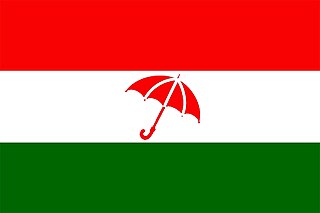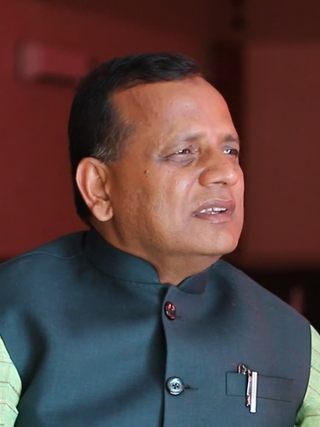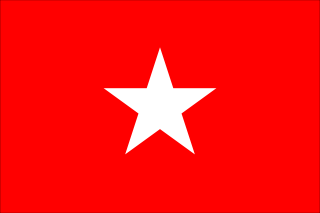Related Research Articles

The Communist Party of Nepal (Unified Marxist–Leninist) (Nepali: नेपाल कम्युनिष्ट पार्टी (एकीकृत मार्क्सवादी-लेनिनवादी), romanized: nēpāl kamyuniṣṭ pārṭī (ēkīkṛt mārksavādī-lēninavādī); abbr. CPN (UML)) is a communist political party in Nepal. The party emerged as one of the major parties in Nepal after the end of the Panchayat era.

The Autonomous Nepalese Provinces were formed on 20 September 2015 in accordance with Schedule 4 of the Constitution of Nepal. The seven provinces were formed by grouping the existing districts. The current system of seven provinces replaced an earlier system where Nepal was divided into 14 administrative zones which were grouped into five development regions.

The Rastriya Janata Party, Nepal, abbr. RJPN was the fourth-largest political party in Nepal after the Nepali Congress, the Nepal Communist Party and the Samajbadi Party, Nepal. It was formed on 21 April 2017 after the merger of Tarai Madhes Loktantrik Party, led by the Mahantha Thakur, Terai Madhes Sadbhawana Party, led by the Mahendra Raya Yadav, Sadbhavana Party, led by the Rajendra Mahato, Nepal Sadbhawana Party, led by the Anil Kumar Jha, Madhesi Jana Adhikar Forum (Republican), led by Rajkishor Yadav and Rastriya Madhesh Samajwadi Party, led by Sharat Singh Bhandari. The party was founded with the ideology of democratic system.

Koshi Province is the easternmost province of Nepal. It is surrounded by Tibet region of China to the north, the Indian states of Sikkim and West Bengal to the east and Bihar to the south and Nepal's Bagmati and Madhesh provinces to the west.

Lalbabu Raut also knows as Mohamed Lalbabu raut is the first Chief Minister of Madhesh Province, one of the seven federal Provinces of Nepal. He is the parliamentary party leader of People's Socialist Party, Nepal for Madhesh Province.

The Koshi Provincial Assembly also known as the Koshi Pradesh Sabha, is the unicameral legislature of Koshi Province, one of the seven provinces in Nepal. The assembly is seated at the provincial capital at Biratnagar in Morang District at the District Coordination Committee Office. The assembly has 93 members of whom 56 are elected through first-past-the-post voting and 37 are elected through proportional representation. The term of the assembly is 5 years unless dissolved earlier.

The Madhesh Provincial Assembly is a unicameral governing and law making body of Madhesh Province, one of the seven Provinces in Nepal, The assembly is seated in the provincial capital at Janakpur in Dhanusha District. The assembly has 107 members, 64 of whom are elected through single-member constituencies and 43 of whom are elected through the party list proportional representation system. They are elected for five-year terms unless the assembly is dissolved earlier.

The Provincial Assembly of Sudurpashchim Pradesh also known as the Sudurpashchim Pradesh Sabha, is a unicameral governing and law making body of Sudurpashchim Province, one of the seven Provinces in Nepal. The assembly is seated a Dhangadhi in Kailali District at the District Coordination Committee Hall. The assembly has 53 members of whom 32 are elected through first-past-the-post voting and 21 are elected through proportional representation. The term of the assembly is 5 years unless dissolved earlier

The provinces of Nepal are governed by provincial governments which form the second level of governance in the country; after the federal government. The provincial governments are established, and their structure is defined by Part 13 of the Constitution of Nepal.
Events in the year 2019 in Nepal.

The People's Socialist Party, Nepal, also known as Janata Samajbadi Party Nepal is the sixth-largest political party in Nepal. Since the 2022 local election, the party has been limited to stand only as the third largest party of Madhesh Province after the Nepali Congress and CPN (UML) respectively. Recently the party faced a major split when 7 of 12 pratinidhi sabha MPs formed a new party, People's Socialist Party under leadership of party's federal council chairman Ashok Rai.

General elections were held in Nepal on 20 November 2022 to elect the 275 members of the House of Representatives. There were two ballots in the election; one to elect 165 members from single-member constituencies via FPTP, and the other to elect the remaining 110 members from a single nation-wide constituency via party-list proportional representation.

In Nepal, the chief minister is the elected head of government of each of the seven provinces. The chief minister is appointed by the governor of the provinces according to Article 167 of the Constitution of Nepal.
Municipal election for Janakpur took place on 13 May 2022, with all 127 positions up for election across 25 wards. The electorate elected a mayor, a deputy mayor, 25 ward chairs and 100 ward members. An indirect election will also be held to elect five female members and an additional three female members from the Dalit and minority community to the municipal executive.

Nawal Kishor Sah Sudi is a Nepalese politician and Minister for Forest and Environment of Nepal. He is also the deputy chairman of People's Socialist Party.
The chief minister of the Madhesh Province is the head of government of Madhesh Province. The chief minister is appointed by the governor of the province according to Article 167 of the Constitution of Nepal. The chief minister remains in office for five years or until the provincial assembly is dissolved, and is subject to no term limits, given that they have the confidence of the assembly.
The first Madhesh Provincial Assembly was elected by the 2017 provincial elections. 107 members were elected to the assembly, 64 of whom were elected through direct elections and 43 of whom were elected through the party list proportional representation system. The term of the assembly started on 4 February 2018 and ended in September 2022. Lalbabu Raut from the People's Socialist Party served as the chief minister during the term of the assembly. Saroj Kumar Yadav served as the speaker of the assembly and Upama Kumari Dev served as the deputy speaker.
The 2nd Madhesh Provincial Assembly was elected through the provincial elections held on 20 November 2022. The assembly has 64 constituency seats in which members are elected through direct elections and 43 proportional representation party list seats. The term of the assembly is 5 years unless dissolved earlier. The first session of the assembly started from 2 January 2023.
Events in the year 2023 in Nepal.

The Government of Koshi, known locally as the Provincial Government, is the supreme governing authority of the Koshi Province which consists of 14 districts.
References
- ↑ "कर्मचारी विवरण | मुख्यमन्त्री तथा मन्त्रिपरिषद्को कार्यालय".
- ↑ "Cabinet recommends guvs, names ad hoc 'workstations'". The Himalayan Times. 2018-01-17. Retrieved 2019-05-31.
- ↑ "Seven chief ministers set to take oath". kathmandupost.ekantipur.com. Retrieved 2019-05-31.
- ↑ "Nepal elections explained". www.aljazeera.com. Retrieved 2019-06-04.
- ↑ "CDC submits its report with 165 electoral constituencies". kathmandupost.ekantipur.com. Retrieved 2019-06-04.
- ↑ "उच्च अदालत जनकपुर". supremecourt.gov.np. Retrieved 2022-01-15.